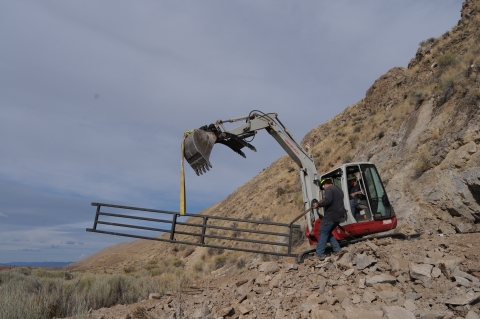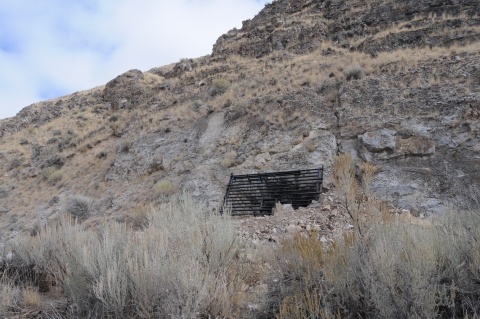Nah, nah, nah, nah, nah Batman! They aren’t lighting up the night sky with the bat signal or speeding away in the batmobile but some bat men and women are helping Idaho’s bats in heroic ways.
It’s no secret that bats are declining across the globe. Disease, habitat loss and human activity, including disruption during hibernation, all play a major role in the decline of bat populations worldwide. But bats have more than a wing and prayer thanks to the work of a creative and dedicated cadre of partners – they have a home.
The Fish and Wildlife Service has teamed up with Idaho Department of Environmental Quality, the Bureau of Land Management, Idaho Department of Lands, and Syensco to transform an orphan mine on a National Wildlife Refuge in Idaho into a bat haven. Thanks to the idea and ambition of Dan Nolfi, Ryan Braham, and Matt Schank, Fish and Wildlife Service biologists, what was once a danger zone for people and animals has been transformed by the installation of a bat-friendly mine closure, creating a safer area for bats and people.
At first glance, an adit is a strange and spooky sight. These manmade horizontal and vertical passages are dug out of bedrock to create access to minerals although it’s easy to imagine hobbits or goblins using them as tunnels to a secret underworld. And there is a secret underworld here of sorts. The dark corridors lead to a place long since closed off to humans and other forms of life. The hope of the partners was to bring back the sounds of wing flaps and fluttering.
This disguised dwelling for bats at Bear Lake National Wildlife Refuge is a byproduct of hard rock mining. Over 100 years ago, miners dug by hand and used explosives to create deep tunnels into the mountain. A rail line was developed to extract the rich phosphate ore bodies, which is the base for plant fertilizer. While the twisting tunnels and murky mines pose a risk to humans, the partners hope bats will be more than happy to move back in after a bit of remodeling. As part of standard safety practice, the mine was sealed up and close to all access – humans and animals – 20 years ago after remediation, or mine closure, was complete.
Despite the creepy cave-like appearance and the clear warnings to keep out, curious people will sometimes enter mine adits, even when it is not safe. This is often a risk that landowners don’t want to take. So, the Bear Lake mine was sealed with clean fill and locked with metal doors that didn’t allow humans or bats to enter.
But the story doesn’t end there. Dan realized that the door had been closed on some prime bat habitat. And bat habitat is crucial because bats are crucial. Bats are often misunderstood, and they are an important animal that we need to work extra hard to protect. Although we may not always see them, bats are relentless in their pursuit of insects, pollinating flowers, and spreading seeds that grow new plants and trees. Insectivorous bats are nature’s pest controllers and save the U.S. agricultural industry an estimated $3 billion per year. They are also essential in pollination and seed dispersal and are important for the health of our forests and diversity of our plants.
It’s possible to close mine adits to unsafe human access but allow bats to use the important roost and hibernation habitat at the same time, and this is exactly what Dan has been seeking to do at this orphaned mine and others across southeastern Idaho. Collaborating with the mining industry across southeast Idaho addresses human-health safety concerns at these abandoned sites while providing potential habitat to the native bats of the region.
###
The U.S. Fish and Wildlife Service works with others to conserve, protect and enhance fish, wildlife, plants and their habitats for the continuing benefit of the American people. For more information, visit https://www.fws.gov/office/idaho-fish-and-wildlife and connect with us on social media: Facebook, Instagram, Twitter, LinkedIn, Flickr, and YouTube.








